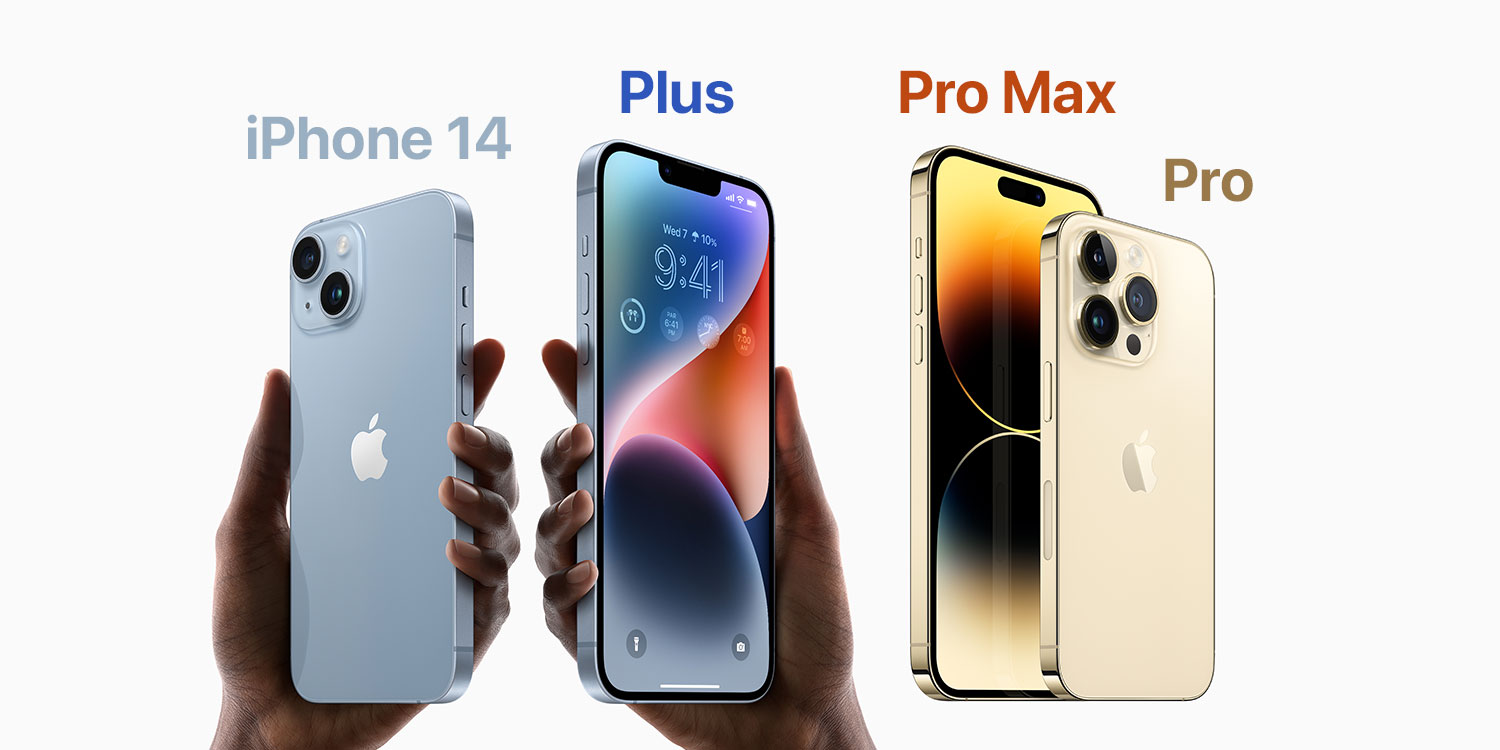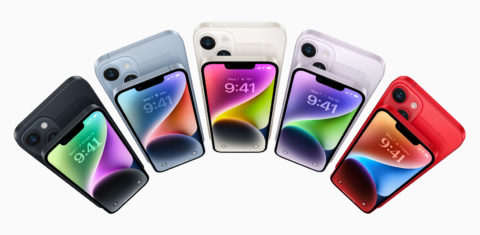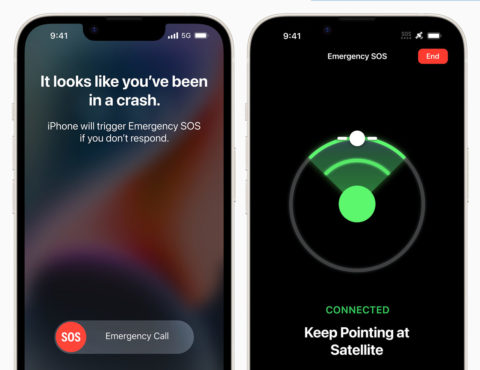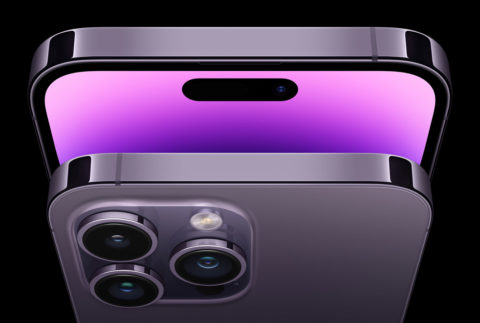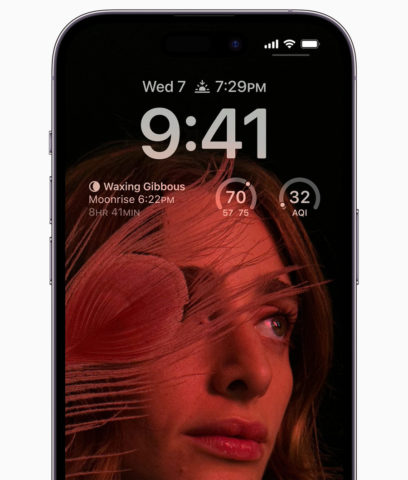Apple unveiled four new iPhones at its big September event. If the choice between iPhone 14, iPhone 14 Plus, iPhone 14 Pro, and iPhone 14 Pro Max has got your head spinning, we’ve got you.
Understanding the lineup
Four models may sound like a lot to digest, but in reality it’s just two models, both available in two sizes.
iPhone 14 is the standard model for 2022, with a familiar 6.1-inch display. iPhone 14 Plus offers exactly the same features and capabilities, packed in a larger casing with a bigger 6.7-inch display.
iPhone 14 Pro is Apple’s high-end offering, with more impressive specs than the standard model but the same size 6.1-inch display. Likewise, iPhone 14 Pro Max is simply the Pro model with a bigger 6.7-inch display.
It’s also worth noting that in addition to a bigger screen, you’ll get a few more hours of battery life from the two larger models, as they have space for bigger batteries.
So, forgetting the size consideration for a moment, what’s the difference between iPhone 14 and iPhone 14 Pro? And how much have they changed since last year’s offerings?
iPhone 14
Let’s start with the iPhone 14. It’s definitely an iterative change over last year; it’s clear that Apple is trying to further differentiate its Pro models by holding back certain changes from the standard model.
iPhone 14 looks exactly the same as last year’s iPhone 13, with the same Super Retina XDR display, the same storage options, and almost* the same A15 chip. So why would you bother to upgrade?
Well, there are a couple of key changes this year that make iPhone 14 stand out…
Cameras
Like its predecessor, iPhone 14 offers two 12MP rear cameras (main and ultra wide), but the sensors have been increased to allow more light in. Combined with machine learning smarts that Apple is calling its “Phototonic Engine,” that essentially means much better low-light photography. Two times better, in fact.
The front-facing TrueDepth camera has been improved too, adding autofocus for the first time – which should make for sharper group shots from a distance. There’s also improved video stabilization with “Action Mode” for recording super-shaky footage, and you can shoot Cinematic Mode video in 4K at 24fps, the industry standard for film.
Safety
Apple had a big focus on safety features this year, the kind you hope to never use but would be extremely thankful for if they ever came into play.
First up, Crash Detection uses iPhone 14’s improved sensors alongside a bunch of impressive motion algorithms to calculate when you’ve been in a severe car crash. If you have an Apple Watch, the detection becomes even more accurate. If a crash is detected, your device will automatically call emergency services, which could be a literal lifesaver if you’re stuck and unable to dial in yourself.
The other safety feature this year is Emergency SOS via Satellite, which for the first time allows users to send messages or Find My location data even when they’re stuck somewhere with no cellular or Wi-Fi connection. iPhone will ask users a few emergency questions and then show them which direction to point the device to connect to a satellite to request help. This feature is coming to the US and Canada in November, and rather ominously, Apple says it will be “free for two years.”
More
There are smaller changes, too. Battery life is slightly improved compared with iPhone 13, and better thermal performance means your device shouldn’t get so hot. There are new Blue and Purple colorways this year, more pastel-shaded than last year’s choices. In the US, the physical SIM card tray is no more, with Apple fully embracing the more convenient eSIM instead.
*That almost-the-same A15 chip we mentioned earlier actually has an extra GPU core, which means its graphics performance is 18% faster than the standard iPhone 13. So it’s better, but not a huge upgrade.
Pricing
iPhone 14 starts at $799/£849 for the base 128GB version. Upgrading to the larger Plus model will run you an extra $100/£100, with additional storage ranging from $100/£110 to $300/£330.
Pre-orders go live at 5am PDT on September 9, with the iPhone 14 shipping a week later but the iPhone 14 Plus not shipping until October 7 due to production delays.
iPhone 14 Pro
Here’s where things get interesting. If you’re thinking the iPhone 14 is slightly underwhelming, the Pro model has you covered with some more significant changes.
It has the same safety features we mentioned earlier, plus the following…
Dynamic Island
With iPhone 14 Pro, Apple’s iconic notch has evolved into a pill-shaped cutout that takes up 30% less space than before while still housing all the essential TrueDepth camera sensors.
But the real change here is how Apple is using this space, which is now called the “Dynamic Island.” Apple’s famously tight integration of hardware and software is at play here, with the island expanding and contracting to show notifications and other activities.
Background activities like timers or music are shown here, and are tappable if you need to interact with them. If you’re tracking multiple things, it seamlessly animates out into separate bubbles. The island can playfully expands to perform Face ID checks, or to confirm that your headphones have connected successfully, or any number of things. And the island is open to third-party apps too, meaning you could get live sports scores or ride-sharing updates right there on the status bar for easy access.
It’s a slick, adaptive feature, and certainly looks impressive in Apple’s demos. How useful it will be in practice remains to be seen, but as an exclusive feature for the top-level iPhone it will certainly turn heads.
Always-on display
An impressive new Super Retina XDR display with ProMotion is a bit of a show-stealer here, boasting the same peak brightness level as a $4999 Pro Display XDR.
A combination of improved power efficiency with a new 1Hz refresh rate allows for something users have been craving for years now: an always-on display.
This looks particularly good with iOS 16’s redesigned Lock Screens, keeping the clock and widgets available while dimming the screen to conserve power. Photo wallpapers will be intelligently dimmed and desaturated while maintaining skin tones, and pop back to life in full color when you tap to wake the display.
Cameras
Again, the “Phototonic Engine” plus some better sensors allow for at least a 2x improvement in low-light photography across all four of the cameras on the iPhone 14 Pro, with the front-facing camera gaining autofocus for the first time. But that’s not the biggest headline here.
The big draw is that iPhone 14 Pro now has a 48MP main camera that uses a “quad-pixel sensor” to take in incredible amounts of detail before combining it down to a familiar and practical 12MP resolution. That means much more quality without resulting in bigger file sizes. It also means the “middle” of the main camera can be used as a full 12MP 2x optical lens, meaning you can now shoot in 0.5x, 1x, 2x, and 3x without using any kind of digital zoom effects. Pretty amazing stuff.
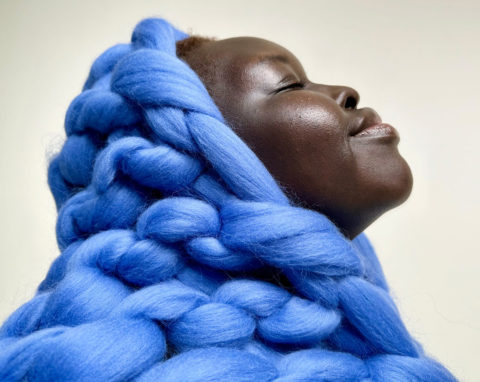
The level of detail possible with the new cameras is incredible, and this compressed version doesn’t nearly do it justice
That massive sensor can also be used to shoot ProRAW video at 48MP, which is a big deal for pro users but probably not something needed for your average home movie.
A16 Bionic
While the iPhone 14 has a chip recycled from last year’s iPhone 13 Pro, here we get Apple’s crowning glory: the A16 Bionic. This processing chip is apparently up to 40% faster than the competition, there’s 50% more memory bandwidth for graphics, and the improved Neural Engine is responsible for all the clever computational photography stuff in the new camera system. A15 was no slouch, but A16 should be powerful enough for more or less any task (or game) you throw at it.
More
Anything else to report? Well, all the same little extras from the standard iPhone 14, plus a lovely new deep purple finish that’s exclusive to the Pro.
Pricing
iPhone 14 Pro starts at $999/£1099 for the base 128GB version, with the larger Max model costing an additional $100/£100. You can get double the storage for another $100/£110, 4x more for $300/£330, or 8x more (1TB) for a whopping $500/£550 extra.
Pre-orders go live at 5am PDT on September 9, with the iPhone 14 Pro and Pro Max shipping a week later on September 16.
